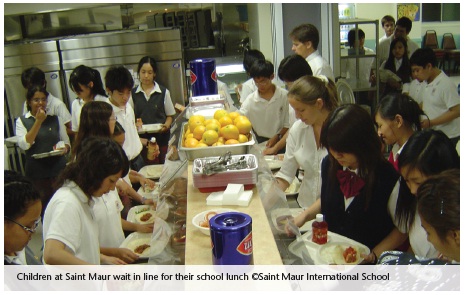From Halal to macrobiotic, there’s a school lunch for you
by Danielle Tate-Stratton
School lunches don’t always have the best reputation, and for good reason—most cafeteria memories we harbor aren’t positive—recalling largely unvaried, unhealthy, and un-tasty meals. The situation in the UK even got so bad that celebrity chef Jamie Oliver recently took it upon himself, with reality TV show Jamie’s School Dinners, to try and overhaul the school lunch system in an effort to help stem the rising tide of obesity in the UK’s children. Combine that with the often squeam-inducing (to our Western palates at least) stories we’ve all heard from Japanese friends about whale meat in school lunches (granted, that practice was largely suspended in the 1980s) and its no wonder that to many of us, the idea of brown-bagging it is highly preferable!
Luckily for Tokyo’s kids, school lunches are improving, and a few schools are leading the pack with healthy and tasty options sure to have you wishing you could swing by to have lunch with your little ones!
Parents at Tokyo International School (www.tokyois.com) can, for instance, order daily meals from the school, which has been using a service called Mutti to provide a variety of choices to students since May of this year. According to Masumi Yoshimura, Director of Global Associates Co., Ltd. (Mutti’s parent company), children have the choice of either an obento or western- style lunch each day. Obentos, which are available in two sizes daily, may include such options as onigiri, karaage (Japanese fried-chicken), or noriben. Westernstyle menus have been developed by Nathan’s Hotdogs, with fresh fruit added daily by Mutti in order to increase the nutritional value. Masumi also encourages close communication between families, schools, and Mutti, saying that: “if we can be associated with the school, parents will be satisfied with our services.”
For health-conscious parents and children, Keiki Intercultural Preschool in Setagaya-ku has recently started offering macrobiotic and vegetarian lunches to their students. Director Mie Ward explains that macrobiotic cooking uses healthy, whole grain foods and focuses on preparing foods that lead to a balanced body and soul. Well-known in North America, macrobiotic diets are being promoted by celebrities such as Madonna as well as some cancer clinics.
Keiki Intercultural Preschool uses a small macrobiotic catering shop to provide its students with healthy menu items such as brown rice, okara (tofu), veggie croquets, and spinach with sesame. In order to further instill healthy eating and cooking habits in its young students, Keiki also offers regular cooking classes as part of its curriculum as well as a Scrumptious Cooking Club offered to children (not necessarily enrolled at Keiki) aged three–twelve. For more information about the school or cooking club, visit www.keikipreschool.com or tel. 03-3703-8778.
Another great option for families is provided by Cezars Kitchen, who started providing lunches to schools in Nagoya five years ago. As well as two schools in Kobe, Cezars now serves Yokohama International School and Saint Maur International School, as well as the US Embassy, here in the Tokyo area.
Chris Zarodkiewicz, President of Cezars International, feels that one of the highlights of Cezars service is their ability to work closely with schools in order to “try and cater to the needs of the individual school. We will look at the student body when deciding which items to serve.” For instance, Cezars currently works with schools that have large Indian or vegetarian populations and as a result, has added familiar, allowed foods to the menu. Additionally, there are plans to begin offering Halal foods to a school with a high population of Islamic students. Besides working with schools, Cezars also involves parents in the process— for instance, they allow parents to limit or completely stop the intake of certain things due to preferences or dietary requirements. Parents are also able to go online, not only to top up accounts, but also to view what their children have eaten—up to two months prior.
For Saint Maur (www.stmaur.ac.jp), who started using the program in August, 2005, it has proved to be very successful. Public Relations Director Gilles Gaury says that prior to using the program, only about 20 percent of the school’s population took advantage of the food they offered while 80 percent brought their own bentos. Now, that number has reversed. He says that most beneficial to families are Cezars’ well-balanced meals, variety, and healthy attitude towards meals, which includes a ban on carbonated drinks and limited fried foods.
Mother Chris Barnstead loves the convenience and variety as well, adding that she also appreciates how there is food available all day so her son Robert, who is 11 and in middle school, can pick up a morning or afternoon snack as required. Her children are fans of their lunches too—with both chefs adept at introducing Japanese foods which appeal to western kids, they get positive comments such as this one from Robert, who exclaims that they make udon “without the fishy taste!” Additionally, his nine-year-old sister, Cali, enjoys making spaghetti “the way I want it”.
With every meal including two or three veggie choices, salads, rice, pastas, sandwiches, onigiri, and meat or vegetarian entrées, Barnstead says she started out appreciating simply the convenience but has since come to appreciate the variety offered to her children and would happily recommend it to other parents, especially for its overall nutritional value. To find out how your school can start using Cezars’ services, Zarodkiewicz suggests you contact him at [email protected]. To simply find out more about the program and view sample menus, visit www.cezarskitchen.com.
No matter which of these programs your school uses, Tokyo’s kids are increasingly gaining access to school lunches that would make Jamie Oliver proud. Itadakimasu!









